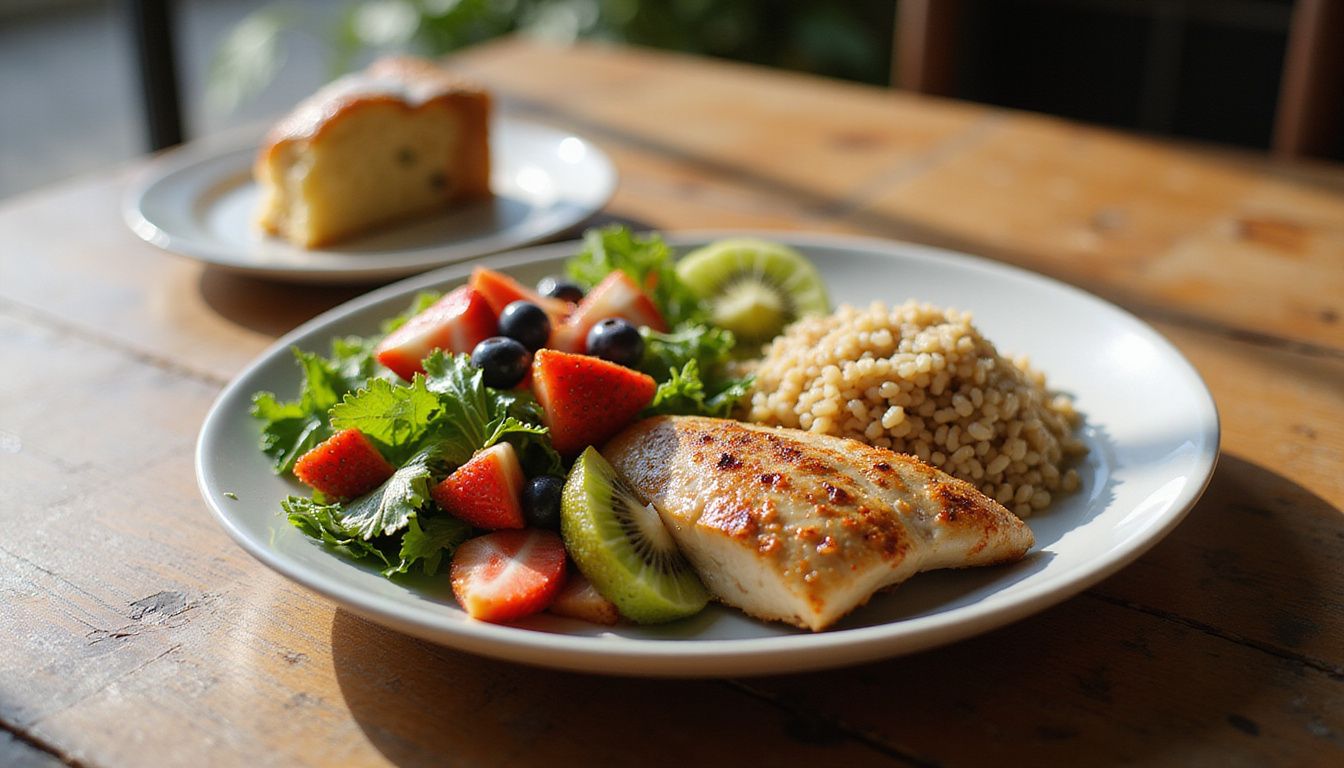80 20 Diet: The Ultimate Rule For Weight Loss Through Healthy Eating
Our Nutrition Assistant AI Suite will transform your body. You will lose fat, get toned, and build muscle. Gain confidence and optimal health.
Strict diets can drain your willpower and steal the joy from eating. The 80/20 Diet offers a balanced approach to healthy eating that is easier to keep. You focus on nutritious foods 80 percent of the time, then enjoy planned treats the remaining 20 percent.
In this guide, you will see why this diet plan supports sustainable weight loss, how to mix healthy choices with small indulgences, and what experts say about this way of eating. You will also learn simple steps you can use right away to build better eating habits.
Small changes add up. You can improve your relationship with food without feeling deprived.
Key Takeaways
- The 80/20 diet means at least 80 percent of your meals feature nutritious foods such as fruits, vegetables, lean protein, and whole grains each week.
- The remaining 20 percent allows treats in moderation. On an 1,800 calorie plan, that equals about 360 calories per day or saved for a few meals.
- Flexible plans like 80/20 improve adherence and lower binge risk compared to rigid rules, according to Nutrition Reviews in 2020 (Smith et al.).
- Registered dietitians, including Keri Gans, support this rule because it aligns with U.S. dietary guidelines and encourages a positive relationship with food.
- Moderation matters. Oversized portions during the indulgence window can stall weight loss and strain health even if the other meals are balanced.

What is the 80/20 Diet Rule?

The 80/20 diet rule helps you make healthy choices most days while allowing room for less healthy options in small amounts. It supports a sustainable lifestyle, not a quick fix.
What is the 80/20 principle in dieting?
The 80/20 principle guides you to choose healthy foods about 80 percent of the time. The other 20 percent can include foods that are higher in sugar, salt, or fat. You do not need to count every calorie or follow complex macronutrient rules to benefit.
Dietitians often recommend this method because it fits the U.S. Department of Agriculture and the U.S. Department of Health and Human Services guidelines. Focus on whole foods such as fruits, vegetables, lean protein, and whole grains. For special occasions, enjoy a slice of pizza or dessert without guilt.
I used this rule the night I had a glass of wine with dinner after a day of balanced meals. It made weight management feel doable because I was not stuck in a restrictive diet.
A balanced diet is simpler to keep when most choices are healthy and treats are planned.
This flexible mindset sets the stage for balance and moderation in a realistic eating plan.
How does the 80/20 rule promote balance and flexibility?
You prioritize nutrient-dense foods, like vegetables, fruit, lean protein, and whole grains, most of the time. Then you allow room for ice cream, wine, or fast food within the remaining 20 percent.
Planning treats reduces the sense of deprivation that triggers rebound eating. You can fit indulgences around events or cravings without guilt. For example, eat a salad with grilled chicken at lunch, then enjoy a cookie after dinner once in a while.
During holiday gatherings, knowing I had flexibility helped me stay on track. Many people keep a healthy weight longer with this approach because it encourages portion control and avoids all-or-nothing thinking.
How the 80/20 Diet Works
The 80/20 diet rule keeps nutritious foods at the center of your eating. It also gives you room for enjoyable treats, which makes the plan easier to maintain.
How do you focus on nutritious foods 80% of the time?
Plan for about 17 of your 21 weekly meals to be nutrient-dense. Use a simple plate method: fill half your plate with fruits and vegetables, then split the other half between whole grains and lean proteins like chicken, beans, or tofu.
Add low-fat dairy such as yogurt or milk, or a fortified plant milk if you prefer. Aim for 2 to 3 cups of vegetables daily. Choose whole grains where the first ingredient listed is a whole grain. Adults usually do well with 5 to 6 ounces of protein each day from sources low in saturated fat.
Pick fat-free or low-fat dairy to limit unhealthy fats. Reduce added sugars and refined grains on most days. Save items like French fries, bacon, white bread, and sugary cereals for occasional use.
Think of each meal as fuel. Nutritious choices build healthy eating habits and make weight management easier.
What are appropriate indulgences for the other 20%?
After focusing on healthy foods 80 percent of the time, you have space for treats in moderation. Examples include a small bowl of ice cream, a cheeseburger, onion rings, nachos, or a sweet coffee drink.
Some people enjoy sugar on grapefruit or whipped cream on berries. Others choose a glass of wine at dinner or fast food at a social event. You can spread your 20 percent over the week, or save it for one or two meals.
On an 1,800 calorie plan, about 360 calories per day can come from treats. Portion control remains key. During my own use of the Pareto principle, keeping indulgences intentional and small helped me stay consistent and enjoy favorite flavors without guilt.
Make treats mindful and occasional so they add pleasure without crowding out nutritious foods. That balance supports heart health and blood sugar control over time.
Benefits of the 80/20 Diet
This approach promotes moderation and consistency. You can lose weight without rigid rules and also build a healthier relationship with food.
How does the 80/20 diet promote sustainable weight loss?
Focusing on nutritious meals 80 percent of the time supports a gentle calorie deficit. Fill most plates with vegetables, fruits, lean protein, nuts, seeds, and whole grains. These foods are rich in dietary fiber and vitamins, and they tend to be lower in calories.
This pattern aids digestion and may lower the risk of conditions like diabetes. Allowing 20 percent for treats reduces the urge to overdo it later. Portion control prevents desserts and fast food from erasing progress.
Extreme diet culture can lead to yo-yo weight changes. A moderate plan helps you stick with lifestyle changes better than strict low-carbohydrate regimens, according to research summaries published in 2022.
How does it encourage a positive relationship with food?
The 80/20 approach lets you keep favorite foods and reduces shame. You eat healthy most of the time, then fit in a dessert or salty snack on purpose and without guilt.
This method values consistency over perfection. Mindful eating habits can lower the chance of binge eating. In my case, allowing small treats during meal prep calmed cravings. Instead of fearing foods, you learn to choose what satisfies both taste and nutrition.
How does the diet help reduce binge eating?
The 80/20 diet can reduce binge eating because indulgences are planned. When you expect a treat, cravings lose their urgency. You feel less deprived, and you do not obsess over restricted foods.
For instance, if you want chocolate or a fast food meal, you plan it into your week. Many people find better hunger control when they pay attention to fullness cues. I saw fewer late-night snack attacks after shifting to a more flexible approach in 2022.
Research links moderate flexibility to lower emotional and compulsive eating risks[1]. The 80/20 rule supports healthy choices and reduces urges to overeat favorite treats.
…
[1] Smith et al., “Flexible Dieting Practices Reduce Binge Eating: A Review,” Nutrition Reviews, July 2020
How does the 80/20 diet allow flexibility in social settings?
Social events become easier when your plan includes treats. Birthday cake, holiday dishes, or a new restaurant sample can fit within your 20 percent.
Many people feel pressure to eat perfectly at gatherings. With 80/20, you still focus on vegetables, fruits, whole grains, and lean meats most days. During events, you can enjoy something special without losing momentum.
This flexibility supports mental well-being and long-term habits. Studies on flexible dieting suggest better adherence over time compared to rigid rules[1]. Planning for social meals keeps your goals realistic and your motivation high.
…
[1] National Institute of Health: Flexible Dieting vs Rigid Dieting Approaches – Impacts on Eating Behavior (2022).
The 80%: Nutritious Eating
Filling most meals with nutrient-dense foods keeps your body energized and your plan on track. Think of it as building a strong base that supports steady progress.
Why emphasize vegetables and fruits in the 80%?
Vegetables and fruits are the foundation. Aim to fill at least half your plate with colorful produce. Most adults do well with 2 to 3 cups of vegetables per day.
Different colors bring different vitamins, minerals, and fiber. This supports heart health, stable energy, and digestion. Fresh and frozen options both work and help you meet goals year-round.
ChooseMyPlate.gov highlights variety for better nutrition. Sauces and oils can add extra calories and salt, so season with herbs when possible. Many people find that eating more plants helps control cravings during the 20 percent.
One parent shared that letting kids pick their fruit for snacks led the whole family to eat a lot more produce week after week.
What role do whole grains play in the diet?
Whole grains provide more fiber, vitamins, and minerals than refined grains. Target about 3 ounces daily, which could be 3 slices of whole grain bread or 1 cup cooked brown rice.
Check labels to ensure whole grain appears first. Oatmeal, quinoa, brown rice, farro, and popcorn are solid choices. Experts note that whole grains slow digestion, which helps keep blood sugar steady.
Cut back on snacks made with white flour to avoid sugar spikes and crashes. Using more whole grains supports healthy weight loss and steady energy. Lean protein also plays an important role.
How to incorporate lean protein sources effectively?
Whole grains give structure, and lean proteins add staying power. Most adults do well with 5 to 6 ounces of protein per day.
Choose from chicken, turkey, lean beef or pork, eggs, seafood, beans, peas, lentils, nuts, seeds, or soy products. Try to include about 8 ounces of seafood each week for omega-3 fats. Grill or bake meats instead of frying, and trim visible fat.
Plant-forward meals like tofu stir-fries or bean salads add fiber and nutrients while keeping calories in check. Rotate your protein sources to get a wide range of vitamins and minerals. If you have medical needs, talk with your doctor before making big changes.
What are good low-fat dairy or plant-based alternatives?
Fat-free or low-fat milk and yogurt provide calcium and vitamin D with less saturated fat. Many adults aim for about 3 cups of dairy daily. If you avoid dairy, choose fortified plant-based drinks such as soy or almond milk.
Limit high-fat options like heavy cream and full-fat cheese. These swaps fit the 80/20 rule because they support a healthy diet and help manage calories.
The 20%: Indulgences
Planned treats make healthy eating feel human. A small sweet or savory item can help you stay on track tomorrow.
What are examples of moderate indulgences like desserts or fast food?
Moderate indulgences might include a small bowl of ice cream, a slice of chocolate cake, onion rings, or a cheeseburger. A glass of wine with dinner also fits here. Some people add a spoonful of sugar to grapefruit or top berries with whipped cream.
These foods work best when enjoyed occasionally and in measured portions. The Academy of Nutrition and Dietetics notes that limiting treat size helps avoid excess calories while still satisfying cravings.
How can you avoid guilt while enjoying treats?
The 80/20 diet removes guilt because you plan indulgences. Choose them on purpose. If there is a birthday party or pizza night, include it in your 20 percent.
Practice mindful eating. Savor each bite. Put down your phone, and notice taste and texture. Use self-compassion if negative thoughts appear. Treats are part of life, not a failure.
Research links planned indulgence to fewer binges and less shame. A positive mindset supports lasting habits and makes your weight loss journey more enjoyable.
What indulgent foods fit within the 20% limit?
Within the 20 percent, options like onion rings, wine, and ice cream can fit if portions are kept modest. Cookies, cake slices, or a fast food item can also work once in a while.
Some people take a calorie approach. For example, up to about 360 calories per day on an 1,800 calorie plan may come from treats, or you can pool those calories for a few meals each week. This gives flexibility while supporting your goals.
Practical Tips for Following the 80/20 Diet
You can make the 80/20 diet fit your routine. Simple planning and tracking go a long way.
How can meal prepping support the 80% nutritious eating?
Meal prep helps you keep most meals nutritious. When balanced meals are ready, you are less likely to grab fast food or vending snacks. Prepare 17 of your 21 weekly meals with vegetables, lean protein, whole grains, and low-fat dairy or fortified plant milk.
Cooking at home gives you better control over ingredients and portions. During a busy stretch last year, meal prep kept me from last-minute drive-thru trips. Research shows people who plan and prep meals eat more fruits and vegetables and tend to consume fewer calories.
What are effective ways to track meals and maintain balance?
Use a food diary or an app to track your 80/20 split. Log meals, snacks, and treats in real time to build awareness and accountability. If you set a weekly allowance for indulgences, keep a running tally so you stay within limits.
Review your week. Confirm that most choices were nutritious and that treats stayed within the 20 percent. Tracking can reveal unplanned snacking or oversized portions, especially at social events. Color-coding helps some people. Green for 80 percent meals, red for 20 percent treats.
Make small adjustments before balance slips. Meal prep supports your nutritious base and reduces guesswork.
What strategies help with mindful indulgence?
Plan treats in advance so they fit inside your 20 percent rather than appearing on impulse. Choose small portions and spread them across the week instead of saving everything for one big cheat day.
Eat treats slowly and without distractions. Focus on flavor and texture to feel satisfied with less. For example, a single piece of dark chocolate after lunch can hit the spot when you truly savor it.
Who Can Benefit from the 80/20 Diet?
This plan suits people who want structure without strict rules. It offers flexibility while keeping you aligned with your goals.
Who should consider the 80/20 diet for sustainable weight loss?
If rigid diets lead you to quit, the 80/20 diet can help. It works well for people who want realistic, steady results instead of short-term fixes. You get a clear framework with room for social eating.
You build balance by making healthy choices most days and keeping favorite foods in the plan. Many people who value simple rules and active social lives succeed with this method.
Why is it good for those wanting a non-restrictive eating plan?
The 80/20 diet is a smart choice if you prefer a non-restrictive plan. You do not have to cut beloved foods, which reduces mental stress. Dietitian Keri Gans supports this rule because it values balance over deprivation.
Flexible approaches can lower binge eating and boost self-compassion. Enjoying pizza or dessert in modest amounts fits neatly into your week. The focus is on adding nutritious foods rather than banning food groups.
This approach eases pressure during social events and family meals. You can share treats and still stay balanced.
Who can improve their eating habits with this diet?
Anyone wanting a gradual shift to healthier choices can benefit. The 80/20 rule gives an easy guide for what most meals should look like. It also reduces guilt around desserts or fast food by setting clear limits.
People with busy schedules appreciate that it works without complex rules. Many find that flexibility at gatherings makes long-term change more likely.
Customizing the 80/20 Diet
You can tailor the 80/20 diet to match your culture, preferences, and health needs. The core idea stays the same, but the details are yours.
How to adapt the 80/20 rule for different dietary preferences?
Use 80/20 with many eating styles, including Mediterranean, vegetarian, or vegan. Keep the 80 percent focused on whole foods and plants. For a vegetarian plate, combine vegetables, beans, whole grains like quinoa or brown rice, and fruit.
For vegans, include dairy alternatives such as almond or soy milk, and use protein sources like lentils or tofu. Shape the 20 percent around your culture or taste. A vegan might pick dark chocolate or dairy-free ice cream. Someone following a Mediterranean pattern might enjoy a feta pastry on occasion.
Adjust the split based on your goals. Reduce indulgence if you want faster weight loss. Add flexibility for holidays or travel. If you have allergies, swap ingredients while keeping the same balance of nourishing foods and planned treats.
What are vegetarian and vegan approaches to this diet?
Vegetarian and vegan versions emphasize plant-based foods for most meals. Protein comes from beans, peas, lentils, nuts, seeds, and soy products like tofu or tempeh. Fortified plant milks such as soy or almond provide calcium and vitamin D.
In my routine, meal prep with a variety of vegetables and whole grains made staying on track much easier. For the 20 percent, try vegan-friendly treats like dark chocolate or dairy-free baked goods. Many fast food places now offer veggie burgers or salads that fit these needs.
Check labels to meet daily vitamin and mineral goals without animal products. Tracking helps keep balance and nutrition in line.
How to adjust the diet for medical or nutritional needs?
If you have diabetes, watch sugar, salt, and saturated fat closely. Eating fewer processed foods may support stable blood glucose. For allergies or intolerances, avoid trigger ingredients in both the 80 percent and the 20 percent.
Meet special nutrient needs with targeted choices. If you need more calcium, pick low-fat dairy or fortified plant milks. If a clinician advises higher protein, include lean meats, fish, eggs, tofu, or beans more often.
Consult a healthcare professional before major changes. This keeps adjustments safe and aligned with your medical history and medicines.
Common Misconceptions About the 80/20 Diet
Misunderstandings can turn a helpful rule into a free-for-all. Clear guidelines protect your progress.
Why isn’t the 80/20 diet a license to overeat unhealthy foods?
The 80/20 diet includes treats, but it does not allow unlimited fast food or sweets. Portion control still matters. Overeating during the 20 percent can cancel the benefits of healthy meals in the 80 percent.
If you routinely exceed your energy needs with large desserts or fried foods, weight gain and higher cholesterol can follow. Use the 20 percent for occasional items like a small ice cream or a few slices of pizza, not for daily heavy meals. Mindful enjoyment means savoring, then stopping before it becomes excessive.
Why is moderation important even in the 20% indulgences?
Keeping treats moderate protects your calorie budget. Regularly doubling dessert portions can add hundreds of calories per week. Research shows that even 100 to 200 extra calories daily may lead to weight gain over time.
Moderation prevents spikes in blood sugar and cravings that make it harder to maintain the 80 percent. Limiting fast food, candy bars, and sugary sodas keeps them as occasional treats, not everyday habits.
Can the 80/20 Diet Help with Weight Loss?
The 80/20 balance supports calorie control without strict rules. It gives you structure and freedom at the same time.
How does the 80/20 balance support calorie control?
Nutritious foods like vegetables, fruits, whole grains, and lean meats tend to be lower in calories and higher in fiber. They keep you full, which helps you eat less overall. With indulgences limited to 20 percent, total calorie intake is easier to manage.
Planning treats lowers the chance of overeating. For example, scheduling pizza with friends made it easier for me to enjoy a slice or two and still stay within my target for the day.
What are the long-term benefits for weight maintenance?
Flexibility helps you keep healthy habits for years. You enjoy favorite foods in moderation, which reduces binge eating and rebound weight gain. Research from Harvard T.H. Chan School of Public Health links balance and moderate indulgence with sustained weight control.
Over time, cravings lose power because no food is forbidden. You build a calmer, more positive relationship with food. That stability makes weight maintenance more realistic.
The Role of Exercise in the 80/20 Diet
Pair your eating plan with movement. Food shapes your energy in, and exercise raises the energy you use.
How does regular physical activity complement the diet?
Regular physical activity helps burn calories and supports a higher metabolic rate while you eat fewer calories. People who combine exercise with structured eating plans tend to stick with both more consistently.
Exercise supports cardiovascular health and mental well-being. Most experts suggest at least 150 minutes of moderate aerobic activity each week, plus muscle-strengthening work on two or more days. Moving your body can make healthy choices feel easier.
What are the benefits of combining strength training and cardio?
Strength training builds muscle, which burns more calories even at rest. Bodyweight moves like squats and push-ups work well. Cardio supports heart health and burns additional calories during workouts.
Combining both improves body composition, helping you lose fat while keeping lean muscle. Research shows this blend can maximize results compared to doing only one type. In my schedule, weekend cycling plus short home strength sessions led to steady progress and more energy.
Challenges and How to Overcome Them
Sticking to 80/20 can be hard during busy weeks or stressful moments. A few simple habits can keep you steady.
How can you stay consistent with the 80/20 balance?
Plan and prep meals to keep most choices healthy. Make a weekly grocery list so nutritious ingredients are always on hand. Track your food with a journal or app to maintain the 80/20 split.
People who track meals are more likely to keep balanced diets over time, according to the Journal of Nutrition Education and Behavior. Review your week and adjust if treats creep in too often. Celebrate small wins. Progress fuels momentum.
What are effective ways to manage cravings and emotional eating?
Allow regular, modest indulgences to avoid rebound cravings. Research shows that cutting favorites completely can trigger binges. Keep treats in the 20 percent to support long-term adherence.
Practice mindful eating. Slow down, and notice hunger and fullness. Use tools like breathing exercises or a food journal to manage stress-related eating. After stressful days, I found that a short outdoor walk or music break helped me skip automatic snacking.
Applying the 80/20 Rule Beyond Nutrition
The same balance that helps your plate can shape your day. Aim for steady effort with room for recovery.
How can you apply balance to other life areas?
Use the 80/20 idea for daily routines. Be productive or active most of the time, then allow space for rest. Follow this with exercise as well. Move regularly, then schedule recovery days.
Practice stress management tools like deep breathing or hobbies during most of your week. Leave room for flexible downtime. This balance supports mental and emotional health along with physical health.
What lifestyle habits help with stress management?
Integrate mindfulness, meditation, and gratitude journaling into your day. Deep breathing and short body scans help you focus on the present. Ten minutes of meditation can reduce anxiety and clear your mind.
Writing in a gratitude journal at night shifts attention to positive moments. Taking short breaks during work improves recovery and lowers burnout risk. Light exercise or reading for pleasure builds resilience. In my week, brief outdoor walks after long meetings left me refreshed and focused.
Example Meal Plan for the 80/20 Diet
This sample plan shows how healthy eating and occasional treats can fit together in a typical day.
What does a balanced breakfast look like?
A balanced breakfast includes whole grains, fruit, and protein or healthy fats. Try oatmeal topped with fresh berries and a sprinkle of nuts. You get steady energy from the oats, antioxidants from fruit, and staying power from nuts.
A simple serving might be half a cup of cooked oatmeal, one-third cup of berries, and one tablespoon of almonds or walnuts. This kind of meal kept me full through busy mornings while supporting weight loss, consistent with findings from Harvard in 2020.
What is a healthy lunch example?
Choose a salad with grilled chicken or fish. Include leafy greens, tomatoes, cucumbers, and sliced avocado. The protein keeps you full, and the vegetables add volume and nutrients.
Use a small amount of olive oil for healthy fats. Keep high-calorie dressings and fried toppings to a minimum. A typical portion could include 3 ounces of grilled chicken, 2 cups of vegetables, and one tablespoon of olive oil.
What is a nutritious dinner option?
Salmon with roasted vegetables is a strong dinner choice. Salmon provides lean protein and healthy fats. Roasted vegetables deliver fiber and vitamins.
Fill half your plate with vegetables. Keep added sugars and unhealthy fats low. A palm-sized portion of salmon usually provides enough protein without too many calories. I often roast carrots, broccoli, and bell peppers at 400°F for about twenty minutes alongside the fish.
How can snacks fit into the 20% indulgence?
After a nutritious dinner, a small treat can fit into your 20 percent. Consider an ice cream cone or a slice of chocolate cake. Keep portions moderate and plan them in advance.
Pair treats with balanced meals to keep your pattern steady. Enjoy snacks mindfully and stop when satisfied. For example, savor one fun-size candy bar instead of grabbing several.
Conclusion
The 80/20 diet gives you a clear path to healthy eating and sustainable weight loss. Most of the time, choose fruits, vegetables, whole grains, lean protein, and low-fat dairy or fortified plant options. The remaining 20 percent leaves room for treats without guilt.
This balanced approach helps you handle social events and family meals while staying focused on your goals. Regular exercise strengthens your results and supports overall health. Many people find they build a lasting, positive relationship with food using this simple rule.
This content is for education and does not replace medical advice. If you have a health condition, talk with a healthcare professional before changing your diet or exercise plan.
FAQs
1. What is the 80 20 diet and how does it help with weight loss through healthy eating?
The 80 20 diet encourages people to eat nutritious foods eighty percent of the time, such as fruits, vegetables, whole grains, and lean proteins. The other twenty percent allows for less healthy choices in moderation. Research shows that this flexible approach can support long-term weight management by reducing feelings of deprivation while promoting balanced nutrition [1].
2. Can I still lose weight if I include treats in my meals using the 80 20 rule?
Yes; studies indicate that allowing occasional indulgences helps many individuals stick to their eating plans over time [2]. This method reduces cravings and supports consistent calorie control.
3. How do I track what counts as eighty percent healthy food versus twenty percent treat food?
You can keep a simple log or use a meal tracking app to record your daily intake. Focus on nutrient-rich options like leafy greens, berries, fish, poultry, beans, and brown rice for most meals. Reserve desserts or processed snacks for special occasions or small portions.
4. Is there scientific evidence supporting the effectiveness of the 80 20 diet for sustainable weight loss?
Several clinical trials suggest that diets which allow flexibility lead to better adherence rates compared to strict regimens [3]. People who follow structured yet adaptable plans often report greater satisfaction and improved health outcomes over time.
Summary: The eighty-twenty rule offers a realistic path toward healthier eating habits by balancing nutritious choices with mindful enjoyment of favorite foods. Evidence suggests this strategy may improve both dietary compliance and overall well-being.
References:
[1] Harvard T.H. Chan School of Public Health – Healthy Eating Plate & Pyramid
[2] Appetite Journal (2017) – Flexible vs Rigid Dieting Approaches
[3] Obesity Reviews (2020) – Dietary Adherence Predicts Weight Loss Success







